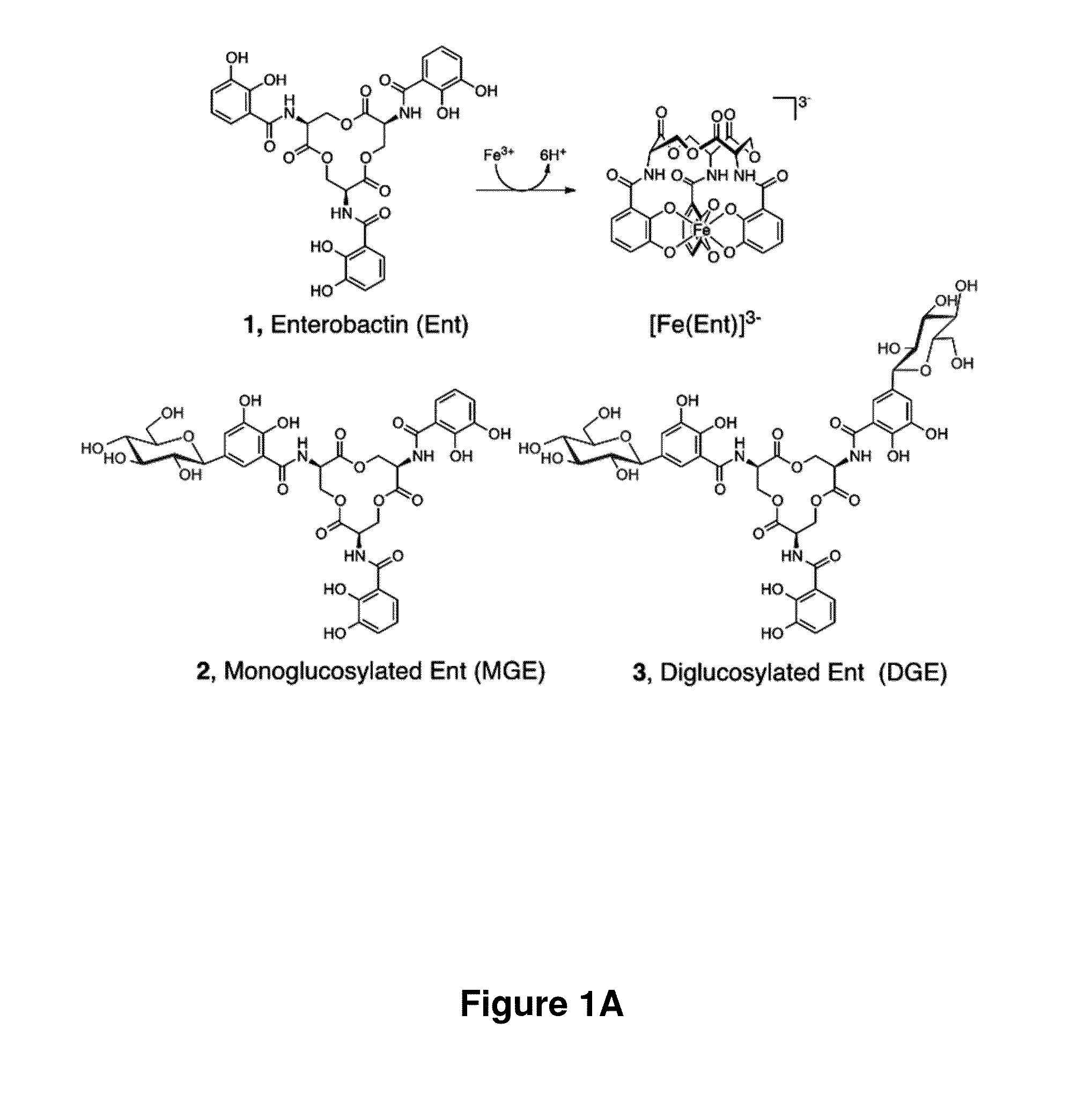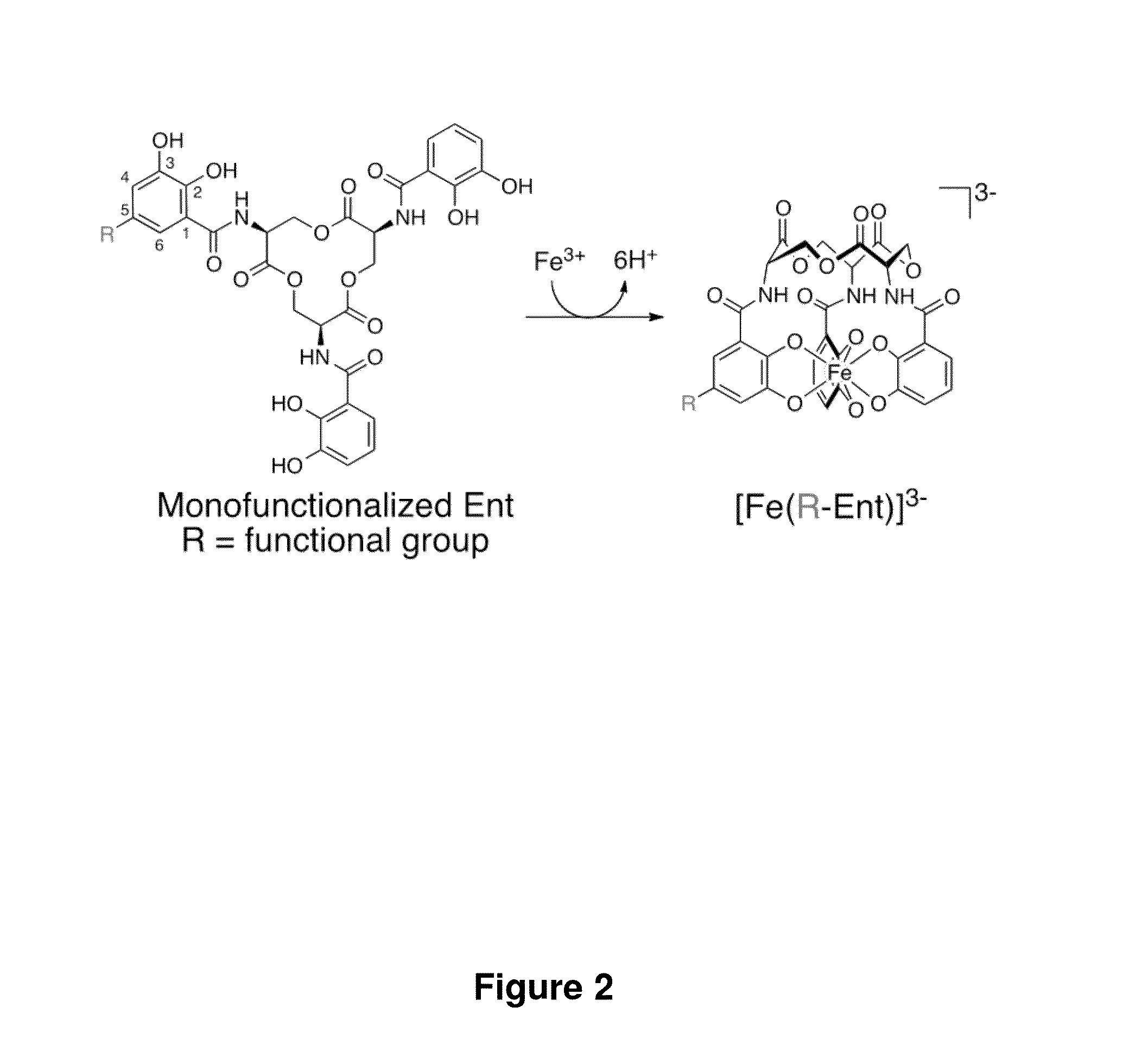Enterobactin conjugates and uses thereof
a technology of enterobactin and conjugates, applied in the field of enterobactin conjugates, can solve the problems of global antibiotic resistance, achieve the effects of reducing or avoiding symptoms or causes of the condition, reducing or minimizing one or more symptoms, and reducing or minimizing the associated symptoms
- Summary
- Abstract
- Description
- Claims
- Application Information
AI Technical Summary
Benefits of technology
Problems solved by technology
Method used
Image
Examples
example 1
Preparation of the Compounds
[0308]The compounds provided herein can be prepared from readily available starting materials using the following general methods and procedures. See, e.g., Schemes 1 to 5 below. It will be appreciated that where typical or preferred process conditions (i.e., reaction temperatures, times, mole ratios of reactants, solvents, pressures, etc.) are given, other process conditions can also be used unless otherwise stated. Optimum reaction conditions may vary with the particular reactants or solvents used, but such conditions can be determined by those skilled in the art by routine optimization procedures.
[0309]Additionally, as will be apparent to those skilled in the art, conventional protecting groups may be necessary to prevent certain functional groups from undergoing undesired reactions. The choice of a suitable protecting group for a particular functional group as well as suitable conditions for protection and deprotection are well known in the art. For e...
example 2
Design and Synthesis of Monofunctionalized Enterobactin Platforms
[0351]An exemplary synthesis of monofunctionalized enterobactin scaffolds is presented in Scheme 1. Functional groups were installed at the 5-position of one enterobactin catechol ring, the 5-position being amenable to synthetic modification. This position is remote from the iron- or gallium-binding hydroxyl groups in addition to the macrolactone (FIG. 2). Prior studies of the salmochelins indicate that modification at this site compromises neither Fe(III) complexation nor the esterase-catalyzed hydrolysis of the macrolactone.33,64 The structure of the antibiotic-siderophore conjugate MccE492 m65 exhibits a monoglucosylated enterobactin derivative attached to a ribosomal peptide. Methyl-5-allyl-3-methoxysalicylate 19 was selected as a starting material. This precursor was demethylated using BBr3 in the presence of DIPEA to prevent HBr addition to the alkene moiety, and 20 was obtained in 53% yield as a white powder. Be...
example 3
Design and Synthesis of Enterobactin-Cargo Conjugates
[0353]Carboxylic acid 25 was selected as a key intermediate for the preparation of enterobactin-cargo conjugates, and evaluated two strategies for appending cargo to the enterobactin scaffold. In one thrust, standard peptide coupling chemistry was employed to link cargo to the enterobactin acid via an amide bond (Schemes 2 and 3). In the second approach, enterobactin-azide 41 was prepared and “Click” chemistry utilized for cargo attachment (Scheme 4). In both cases, benzyl deprotection unmasked the enterobactin catecholates in the final step.
[0354]A variety of commercially available molecules housing carboxylic acids were selected as cargos. The cargos presented in Scheme 2 vary in size and shape and include a simple Boc protecting group, cyclohexane, naphthalene, phenylmethylbenzene, ciprofloxacin, and coumarin 343 (shown below). This selection includes cargo expected to be non-toxic (e.g., Boc, cyclohexane) in addition to an ant...
PUM
| Property | Measurement | Unit |
|---|---|---|
| Mass | aaaaa | aaaaa |
| Atomic weight | aaaaa | aaaaa |
| Composition | aaaaa | aaaaa |
Abstract
Description
Claims
Application Information
 Login to View More
Login to View More - R&D
- Intellectual Property
- Life Sciences
- Materials
- Tech Scout
- Unparalleled Data Quality
- Higher Quality Content
- 60% Fewer Hallucinations
Browse by: Latest US Patents, China's latest patents, Technical Efficacy Thesaurus, Application Domain, Technology Topic, Popular Technical Reports.
© 2025 PatSnap. All rights reserved.Legal|Privacy policy|Modern Slavery Act Transparency Statement|Sitemap|About US| Contact US: help@patsnap.com



